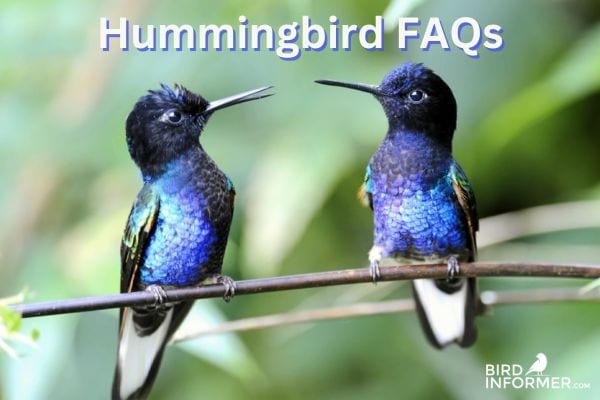Contents
- FAQs About Hummingbirds
- How do hummingbirds react to people?
- Where can I place my feeder so hummingbirds will find it?
- Which is better, a glass or plastic feeder?
- Why don’t hummingbirds use my feeder?
- When do hummingbirds feed?
- How often should I refill my feeder?
- How Hummingbirds Interact With Other Birds
- How Hummingbirds Mate
- What Are Hummingbirds Social Patterns?
We can all agree that hummingbirds are an absolute marvel of nature. With their iridescent plumage and turbo-charged wings, these tiny creatures hold an undeniable charm that fascinates us all.
In this post, we promise to take you on a journey into the hummingbird’s world, addressing some of the most frequently asked questions about these petite powerhouses. If you’ve ever wondered about their diet, flying speed, migration patterns, or how they manage to hover in place like a tiny helicopter, you’re in the right place.
We’ll be unveiling the mystery behind their rapid wing-flaps, discovering why they’re attracted to certain colors, and even exploring their role in the ecosystem. So, grab a cup of coffee and settle in for an engaging, fact-filled exploration into the magical world of hummingbirds.
With this, we embark on our journey. By the end of it, you’ll be the go-to person in your circle for all things hummingbird. Let’s take flight!
FAQs About Hummingbirds
How do hummingbirds react to people?
Hummingbirds can get used to people and interact with them. Put out multiple feeders and build up traffic in your yard. Then, start sitting in your yard. The hummingbirds can become curious and investigate you. Finally, hold a container of sugar water and a hummingbird may come to feed. You may have to take your other feeders down temporarily.
Where can I place my feeder so hummingbirds will find it?
Hang your feeder in partial shade, but make sure a hummingbird can see it in flight. The shade keeps the sugar water from spoiling. Place it where hummingbirds will feel safe within 10 to 15 feet of protection and 5 feet above the ground. There should be nothing planted underneath it, but having flowers nearby that attract hummingbirds helps. A bit of red helps, but not red food coloring. Of course, it should be placed where you can see it.
Which is better, a glass or plastic feeder?
If you buy a plastic feeder, make sure it is BPA-free. Plastic is lighter and not as breakable as glass. However, plastic can fade, crack, and warp, so the glass can be more durable over time. Glass feeders can also be easier to clean.
Why don’t hummingbirds use my feeder?
If you haven’t had any hummingbirds at your feeder yet, they just may not have found it yet. Your sugar and water blend could not be correct. You also need to know what time of year hummingbirds are in your area.
When do hummingbirds feed?
Hummingbirds may use your feeder any time during the day. However, they may be more likely to feed from dawn to early morning and from late afternoon to dusk.
How often should I refill my feeder?
It depends on how warm it is. During really warm temperatures, you should change it every two to three days. During cooler weather, you can change it every five to seven days. The goal is to keep the solution from spoiling.
How Hummingbirds Interact With Other Birds
Since hummingbirds are so small, they are prey for raptors. They are also intimidated by larger birds, so keep their feeders away from bird feeders for other birds.
How Hummingbirds Mate
The male hummingbirds gather in the tropics to form leks. They sing to attract the females. When the females arrive, the males compete to attract a mate. During a courtship dive, hummingbirds can reach up to 45 mph.
What Are Hummingbirds Social Patterns?
Because of their concern for protecting their food sources, other hummingbirds are seen as competitors, so they may chase other hummingbirds away from what they consider to be their territory even when they are migrating. The only time that hummingbirds socialize is mating season, but they don’t even permanently mate. Instead, the female tends to the eggs and the chicks.
If several hummingbird species are living in the same area, the species with the largest population will control the flowers. The less populated species have to slip in to feed.

